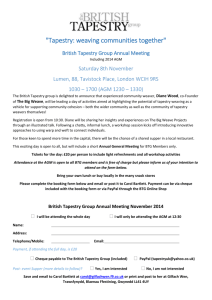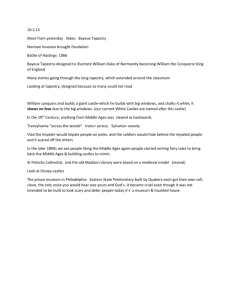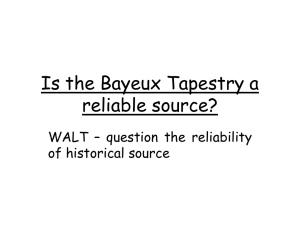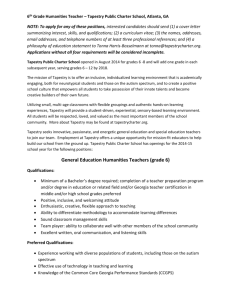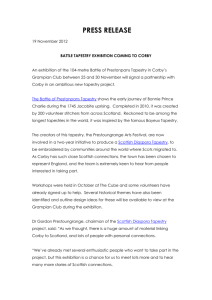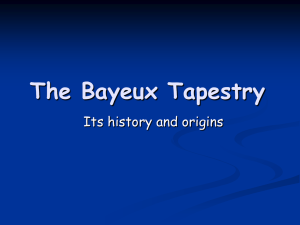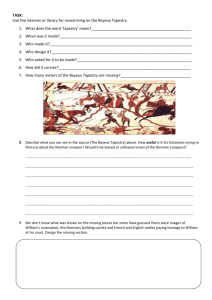Visual Metaphor - Leanne Sauve Portfolio
advertisement
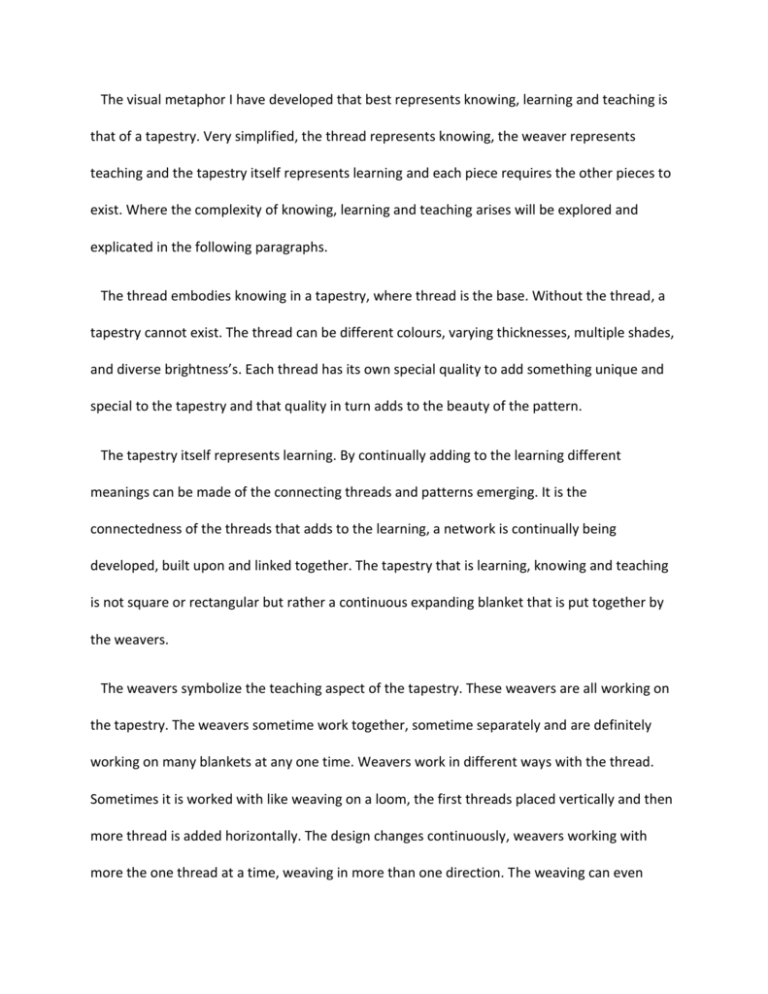
The visual metaphor I have developed that best represents knowing, learning and teaching is that of a tapestry. Very simplified, the thread represents knowing, the weaver represents teaching and the tapestry itself represents learning and each piece requires the other pieces to exist. Where the complexity of knowing, learning and teaching arises will be explored and explicated in the following paragraphs. The thread embodies knowing in a tapestry, where thread is the base. Without the thread, a tapestry cannot exist. The thread can be different colours, varying thicknesses, multiple shades, and diverse brightness’s. Each thread has its own special quality to add something unique and special to the tapestry and that quality in turn adds to the beauty of the pattern. The tapestry itself represents learning. By continually adding to the learning different meanings can be made of the connecting threads and patterns emerging. It is the connectedness of the threads that adds to the learning, a network is continually being developed, built upon and linked together. The tapestry that is learning, knowing and teaching is not square or rectangular but rather a continuous expanding blanket that is put together by the weavers. The weavers symbolize the teaching aspect of the tapestry. These weavers are all working on the tapestry. The weavers sometime work together, sometime separately and are definitely working on many blankets at any one time. Weavers work in different ways with the thread. Sometimes it is worked with like weaving on a loom, the first threads placed vertically and then more thread is added horizontally. The design changes continuously, weavers working with more the one thread at a time, weaving in more than one direction. The weaving can even change to a more circular form, starting at the centre and growing out. This makes the tapestry more than one dimensional, building out front and back. The designs that weavers make are different in every tapestry and there is no wrong or right design. The framework of this blanket is not finite and is never complete rather it is continually evolving, growing and expanding. Each design is beautiful and unique and provides warmth and strength to the receiver of the tapestry. Looking at the visual metaphor of the tapestry, I can see the action of weaving with thread as a drawing in and drawing out in its simplest from. This connects with the gnosis branch of the correspondence theory of learning where the mystic branch of the tree references a drawing in of information for reflection and the religious branch raises the idea of drawing out evil or wrong information. In this simple form, the tapestry represents correspondence theory but it would be beneficial to move beyond this representation and see a connection with coherence theories of learning. Viewing the tapestry through a construetivism lens, I am able to see where an interruption in the pattern of the tapestry has a special place. When the weaver, whether intentionally or unintentionally, interrupts the design of the thread placement, adding to the uniqueness of the tapestry making it more individual and different than any other tapestry before or yet to come. The same can be said of the idea of interrupting learning; I must re-think, re-evaluate or reconstrue my learning when someone interrupts the flow of it. Where does the branch of critical pedagogy become exposed in the tapestry? I see the link in the empowering aspect of this coherence theory of learning. The weavers link the threads in the tapestry through a multitude of designs but it is the linking of the threads that empowers the receiver of the tapestry. These two ideas address the idea of coherence in and of the human world but what about beyond? Through participatory pedagogy the metaphor of the tapestry plays a very important role. Not only do we all receive a tapestry, or perhaps several tapestries and even parts of several tapestries throughout our lifetime but we are also, in many different capacities, the weavers of others tapestries. Where this fits in participatory pedagogy is that making the receiver of a tapestry also one of the weavers of their own blanket, engages them as a participant in their own meaning making. As a weaver of tapestries, I know that by interrupting the patterns and there by empowering the tapestry receiver, I can engage students to create and add to their own tapestry and to others. I value teaching for its reciprocity. When I am teaching, I am sharing, caring and nurturing and concurrently feel that I am being cared for, having things shared with me and being nurtured personally and professionally. This reciprocal relationship allows for a more complex and beautiful tapestry to evolve. This metaphor resonates with me for a number of reasons first of which is my participation in handcraft arts. I am able to sew and weave basic patterns and design in fabric and wool. I find joy and satisfaction in this exercise and have shared this enjoyment with my children, working on projects such as stick weaving of scarves and hot pads. Each project is different from the other, growing from the learning that happened before and, as the project evolves, becoming a unique and individual creation. I also consider tapestry to be a beautiful and intricate art form much the same as teaching is beautiful and complex. The threads chosen, the intricacies of the pattern design and the ability of the weavers are not stand alone pieces, they exist coherently together to share a beautiful art piece with the world. It is a perfect visual metaphor for me to draw on because of my personal experiences and perspectives.
